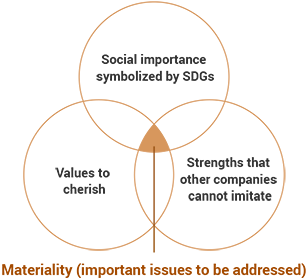Policies and Strategies
Yukiguni Maitake has identified seven materialities as important themes to be addressed in order to achieve sustainable growth and solve social issues. We will set directions and goals for measures for each of the seven materialities and manage the progress of these initiatives. In addition, we plan to review the identified materialities and their goals periodically in line with the environment surrounding us.
-

Environment
-

Society
-

Governance

Environment
Procurement of raw materials and
use of water resources in a sustainable way
Contribution to SDG Goals
Risks
- Increase in costs to respond to changes and tightening of legal restrictions related to wastes and resource circulation
- Damage to corporate value due to slow response to water resource conservation
- Insufficient procurement and damage to corporate value when the sustainability of forest resources is impaired
Opportunities
- Cost reduction and corporate image improvement through waste reduction, recycling, and development and use of environmentally friendly products
- Stable product supply utilizing abundant water resources
Priority themes
- Switch to and development of packaging materials made from environmentally friendly materials
- Introduction of production process using only sawdust that does not lead to deforestation
- Continuation of appropriate water management (water intake/drainage)
Action Policy/Target
- Use of sustainable packaging materials such as 100% recycled plastic
- Supplier management and on-site checks to ensure that sawdust procured does not lead to deforestation
Related page

Environment
Response to Climate Change
Contribution to SDG Goals
Risks
- Increase in costs such as carbon tax due to the transition to a low-carbon society
Opportunities
- Stable product supply by building a system that is not affected by climate change
Priority themes
- Implementation and management of measures in accordance with the short-, medium-, and long-term roadmaps for GHG emissions reduction
- Stable production and supply of products with facility cultivation even under unstable weather
Action Policy/Target
- By FY 2030, reduce emissions by approximately 35% compared to FY 2020, based on emissions intensity and production volume
Related page

Society
Realization of a healthy society with safe, secure,
and high-quality mushrooms
Contribution to SDG Goals
Risks
- Suspension of product supply and loss of trust from customers due to food accidents, etc.
- Decrease in customers’ opportunities to choose our products due to abundant supply from competitors
Opportunities
- Enhanced competitive advantage through the provision of safe, secure, and high-quality products with superior health functionality
- Development of new markets through overseas expansion
Priority themes
- Production of highly safe products based on ISO22000 and ASIAGAP
- Expansion of overseas operations
- Development of products with excellent health functionality and taste
Action Policy/Target
- Zero serious quality incidents (product recall cases)
- Expansion of coverage by various certifications (entire group)
- Overseas revenue ratio of 30% (fiscal year ending March 31, 2026)
- Revised overseas revenue ratio of 6 to 7% (fiscal year ending March 31, 2028)
(Expect around 30% on the upside.)
Related page

Society
Coexistence with local communities
Contribution to SDG Goals
Risks
- Decrease in regional population due to declining birthrate and aging population in hilly and mountainous areas and younger generations’ migration into urban areas
Opportunities
- Talent acquisition by creating a living environment blessed with nature and a comfortable workplace
- Revitalization of local economies by creating business opportunities through cooperation with local governments and contribution to problem solving
Priority themes
- Contribution to local communities through participation in government-sponsored organizations and support for local events
- Promotion of food education through various activities, such as increased engagement with local schools
- Continuation of Yukiguni Maitake Forest Creation Activities
Action Policy/Target
- Participation: 2 or more activities
- Sponsorship: 14 or more activities
- Regular acceptance of field trips from local schools (at least once a year)
- Provision of opportunities to come into contact with nature through Yukiguni Maitake Forest Creation Activities
Related page

Society
New value creation with mushrooms
Contribution to SDG Goals
Risks
- Decline in competitiveness due to slow product development and production technology innovation, and shortage of labor due to delays in factory automation
- Continuous maintenance costs for inefficient existing facilities
- Loss of opportunities to create new revenue-generating businesses due to delayed new business development
Opportunities
- Development of production technology innovation and factory automation by hiring experts and taking advantage of their knowledge
- Creation of new corporate value with a business model centered on agriculture
- Acquisition and utilization of intellectual property for production technology and new business through innovation
- Enhanced corporate image as an advanced company in harmony with nature
Priority themes
- Evolution to a highly efficient factory that makes full use of the latest technology, and investment and utilization of intellectual property and intangible assets in production technology
- Search for business opportunities in the areas surrounding mushrooms and creation of new value through the development of new products taking advantage of our long-standing knowledge and experience
Action Policy/Target
- Reduction of labor equivalent to a maximum of over 200 workers in production and packaging processes by FY2027
- Raise the revenue composition of niche and premium businesses, such as new businesses, to 21% of total revenue by FY2027
Related page

Society
Investment in human capital and respect for
human rights
Contribution to SDG Goals
Risks
- Shortage of workforce due to the declining birthrate and aging population and diminishing working-age population in Japan
- Outflow of top talent with upward mobility
- Increase of communication/ cultural/ religious frictions and associated burden within the company
- Reputational risk and business risk due to lack of respect and consideration for human rights throughout the supply chain
Opportunities
- Improvement of employee engagement by providing a stable and secure workplace
- Improvement of the competitiveness of the entire organization by enhancing the development of individual employees
- Creation of new ideas and business opportunities, and improvement of organizational strength through mutual cooperation among departments and individuals
Priority themes
- Development of talent who will lead the next generation (offering opportunities for skill improvement and career development)
- Creation of an environment where employees can work for a long time and play an active role regardless of gender, age or nationality
- Creation of a safe and harassment-free workplace
- Protection of human rights throughout the supply chain
Action Policy/Target
- Establishment of a system that can provide support for skill improvement and career development opportunities
- 30% women in managerial and supervisory positions (FY2030)
- 100% childcare leave acquisition rate for both male and female employees
- Employee surveys and improvement measures
- Zero serious occupational accidents
- 100% participation in harassment training
- CSR questionnaire surveys and improvement measures
Related page

Governance
Fair, transparent, and sound business activities
Contribution to SDG Goals
Risks
- Decrease in trust and damage to corporate value due to serious compliance violations
- Information leakage or data damage due to fraud or cyber terrorism
Opportunities
- Establishment of a foundation for stable growth by establishing a robust governance system
- Improvement of corporate value through stakeholder dialogue
Priority themes
- Strengthening governance system
- Thorough compliance with internal rules and laws and regulations
- Enhanced disclosure that contributes to better understanding of stakeholders
Action Policy/Target
- Evaluation of the effectiveness of the Board of Directors and implementation of improvement measures based on the evaluation (including evaluation by a third-party organization during FY2023)
- Zero serious compliance violations
- Enhanced information disclosure through various media
Related page
Materiality identification process
Step 1
Creation and evaluation of long lists
Based on the framework below, we evaluated indicators related to sustainability based on the two axes of "importance of social demands" and "importance to company's business," and created a long list of extracted items.
Reference materials
- GRI Standard
- SASB
- Core issues and issues of social responsibility in ISO26000


Step 2
Narrowing down materiality candidates
Create a short list by grouping the items extracted in the long list into similar categories. The 46 items on the short list are evaluated based on the three criteria of "social importance," "strengths," and "values," and narrowed down as materiality candidates.


Step 3
Board approval
Based on the candidates narrowed down in STEP 1 and 2, the Sustainability Promotion Committee creates a tentative proposal. Ultimately, the results are compiled based on the opinions of management, and after obtaining approval from the Board of Directors, materiality items, the direction of measures, and goals are determined.















